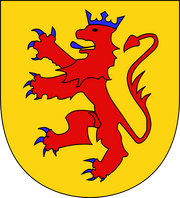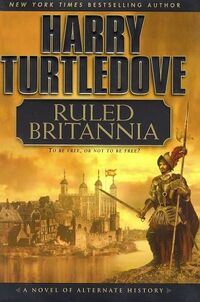
The Hapsburg (or Habsburg) and the successor family, Habsburg-Lorraine, were important ruling houses of Europe and are best known as the ruling Houses of Austria (and the Austro-Hungarian Empire) for over six centuries. They also at times controlled Germany, Spain, and (arguably) Mexico (see Emperor of Mexico for details on the latter).
Hapsburg in Crosstime Traffic[]
Literary comment[]
In Curious Notions and The Disunited States of America, the Austro-Hungarian Empire survives in the late 21st century. While not stated, it is probably the case that the House of Hapsburg is in power in both alternates.
Hapsburg in Ruled Britannia[]
Under the Hapsburg monarch Philip II, Spain expanded its own empire, and concurrently, the influence of the Hapsburgs throughout Europe.
In 1588, Philip's daughter Isabella was installed as Queen of England. She married Albert, her cousin and an Austrian Hapsburg, who became England's King.
After Philip II died, Isabella and Albert were overthrown by a popular uprising led by Robert Cecil and barely manged to flee England in a boat sailing down the Thames in the night. Spain continued to be ruled by the Hapsburgs in the person of Philip II's son Philip III, the younger half-brother of Isabella.
Hapsburg in Southern Victory[]
In the 19th Century, the House of Hapsburg was able to extend itself into Mexico, when the Austrian Emperor's brother, Maximilian I, was installed as Emperor of Mexico by France in the 1860s. Maximilian founded a Hapsburg dynasty that, supported by the Confederate States, continued to rule Mexico into the 20th Century. As a consequence of realpolitik, the Mexican Hapsburg emperors aligned themselves with the Entente despite their Austrian cousins' membership in the Central Powers.
The assassination of the Hapsburg Archduke Franz Ferdinand in 1914 touched off the Great War. As Austria-Hungary was an ally of the United States, and Mexico was an ally of the Confederate States, the two Hapsburg branches were nominally enemies, although neither country met the other on the field of battle.
Austria-Hungary was on the winning side of the Great War, and Mexico was on the losing side. While both branches of Hapsburgs still retained their respective imperial thrones, each saw unrest. Under Emperor Charles, Austria-Hungary was wracked by nationalist uprisings from its various subject peoples, although the direct danger to Hapsburg power was minimal. Mexico saw civil war in the 1920s when anti-Hapsburg popular revolutionaries, with tepid support from the U.S., attempted to overthrow the sitting monarch, Maximilian III. However, the Hapsburgs and the monarchist faction were more fiercely supported by the C.S., and Maximilian III kept his throne.
During the Second Great War Emperor Francisco José II was a staunch ally of Confederate President Jake Featherston, although his loyalty was maintained by a certain amount of coercion. Likewise, in Europe, Austria-Hungary maintained its obligation to the Central Powers.
Austria-Hungary was again on the winning side, and Mexico on the losing side. However the Hapsburgs still remained in power in Mexico, as the triumphant U.S. bowed to necessity as it began an extended occupation of the Confederate States.
Hapsburg in The Two Georges[]
An Emperor from the House of Hapsburg ruled over the modest Austrian Empire in the late 20th century.[1]
Literary comment[]
The name Hapsburg is only mentioned once in the novel, and no individual members of the dynasty are described or even named.
Other Hapsburgs[]
Carlos I of Spain (aka Charles V, Holy Roman Emperor) is referenced as the reigning monarch in "Eyewear". He is not directly affected by the speculative elements of the story, which may or may not be set in OTL.
Joseph II, Holy Roman Emperor, is referenced as the reigning monarch in "The More it Changes."
References[]
- ↑ The Two Georges, p. 320 HC.
| |||||||||||||||||||
| |||||||||||||||||||||||||












